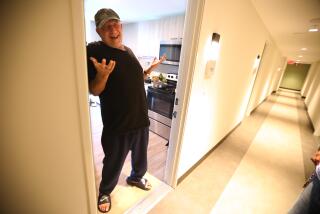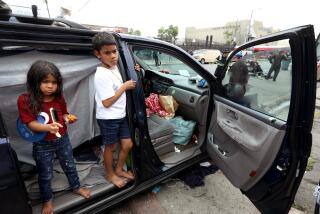Cardboard Castle : Skid Row Artist Lives in Makeshift Home of Boxes That Features Refinements Seldom Found on the Street
- Share via
Before police and sanitation workers arrive on Skid Row every morning to clear off the sidewalk, a 41-year-old man named Kamal drags his elaborate, 30-square-foot cardboard house for three blocks, placing it under a tunnel to save it from the city dump.
All along Main Street, dozens of homeless people fashion raw shelter out of cardboard boxes, while others simply use small blankets. Kamal, a self-taught artist who began living on the streets two weeks ago when he could no longer stand the drug-infested hotels nearby, attempted to redeem himself by building grander shelter.
Working with huge boxes he finds at nearby businesses, he has constructed a house with a roof, windows, curtains and a door. For landscaping he places branches in a crate outside. Above his front window reads a sign, “Portraits by Kamal.” He draws them with a box of art supplies that he keeps inside. A small space beside his house serves as a driveway for his shopping cart, which is decorated with tattered ribbons.
“When you build your own house, you are respected more,” said Kamal, part philosopher, part realist, so embarrassed to be living on the street he asks that his last name not be printed. “It shows that you care. I am an artist terminally. I think you can make your life beautiful at whatever level you’re on.”
He ties together the corners of boxes with shreds of clothing and props up the roof with a couple of cardboard cylinders taken from the inside of paper rolls. Even though he is more than six feet tall, he can nearly stand up inside. A tarp hangs over the roof, neatly tucked in on each side. His artwork decorates the exterior. It serves him far better than the average cardboard box, not counting the rainy day it caved in.
During the day, Kamal, who has never taken an art class, can usually be found at 1st Street and Broadway, where he sketches portraits in charcoal, using a simple snapshot as a model, for $25. Lately, he said, business has been slow, and by the end of the day he often doesn’t have enough for a plate of beans and rice at the local taco stand.
Originally from New York, Kamal said he learned to draw by reading art books and watching others. He was able to make a living plying his trade on New York streets, but since coming to Los Angeles 13 years ago he has had less luck. Many times, he says, would-be patrons back out of paying after Kamal creates their portrait.
“They stiff me,” he said indignantly. “One guy wanted to pay me in stolen shoes but I didn’t want that. I use all my supplies and they don’t want to pay.”
Art, he says, is his salvation.
“I am happy when I can be creative. It makes you use your mind and you don’t always have to wait for people to give you something. You can do it yourself.”
A woman named Shay, who has lived nearby on Main Street for a year and also declined to give her last name, said Kamal is a good man who shares what he has and looks out for her possessions.
“He drew all these pictures,” Shay said proudly, pointing to the art taped to Kamal’s cardboard house. “And he doesn’t use anything. No drugs, no booze.”
Kamal says some of the homeless resent him because his house reminds them of what they lack. “But I say just because you are out here, don’t mean you have to give up.”
He hopes to save his earnings and one day buy a motor home. For the short-term, he envisions building a better house with plywood, possibly with wheels underneath so he can “just roll away” when city workers come to clear the streets.
For now, day-to-day survival takes precedence.
“I am grateful God gave me the talent to create things, but I am not proud,” he said, “There is no way in the world that God wants me to do this and be on the street.”
More to Read
The biggest entertainment stories
Get our big stories about Hollywood, film, television, music, arts, culture and more right in your inbox as soon as they publish.
You may occasionally receive promotional content from the Los Angeles Times.










